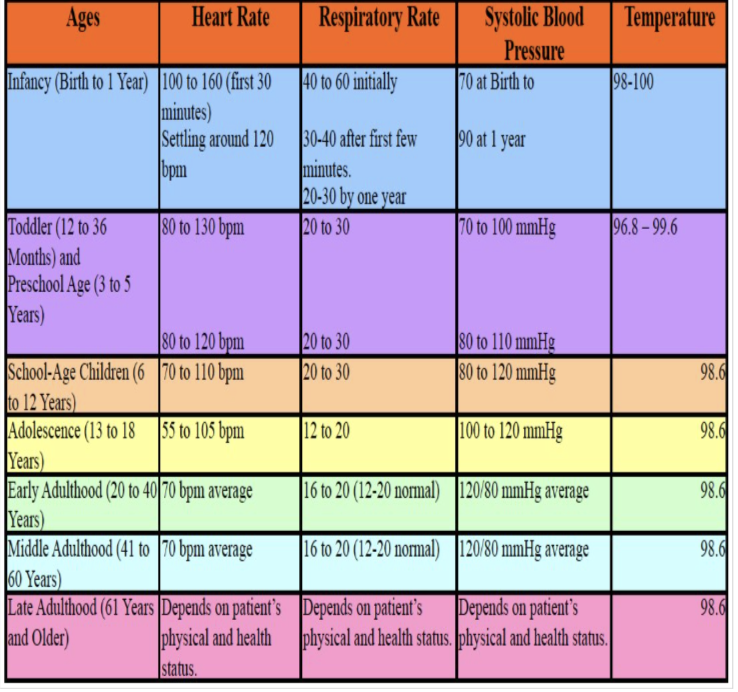Vital Signs and SAMPLE
1/33
There's no tags or description
Looks like no tags are added yet.
Name | Mastery | Learn | Test | Matching | Spaced |
|---|
No study sessions yet.
34 Terms
When is SAMPLE used?
It is used during patient assessment to gather medical history, which is important for medical assessments and relevant for trauma patients
What does SAMPLE stand for?
S - signs (what I see) and symptoms (what pt tells me)
A - allergies
M - medications (prescribed, OTC, herbal - what pt tells me)
P - past medical history (important stuff: hospitalizations, chronic conditions, etc.)
L - last oral intake (what pt ate and drank and when)
E - events leading up to situation (e.g. when was the last time pt felt well)
What are the main vital signs?
Pulse
Respiration
Pupils
Skin (color, condition, temp)

What are vital signs and why are they important?
They are outward signs of what’s going on in a patient and help establish a trend in their conditions
Baseline of Vitals
The first set of vitals completed upon encountering a patient
What is pulse rate and how is it counted?
Number of heartbeats per minute
Palpate for 30 seconds and then multiply by 2 to obtain bpm
Normal pulse rate for adults at rest
60-100 bpm
Tachycardia
Above 100 bpm
Bradycardia
Under 60 bpm
What can be considered serious when discussing pulse rates?
Below 50 bpm
Above 120 bpm
Pulse Rhythm
It reflects the regularity of the pulse
Pulse can be:
regular (interval between beats are constant)
irregular (interval between beats aren’t constant)
regularly irregular (irregular pattern repeats in predictable way - beat beat pause beat beat pause)
Pulse quality
Reflects how strong the pulse is
Weak: is associated with other symptoms
Thready: is associated with an irregular rhythm
Strong: a regular pulse
Bounding: a pulse associated after a exercise session
How to check radial pulse?
Place index and middle finger on wrist below thumb
What are vital sign respirations?
The act of breathing in and out
What is measured when examining vital sign respirations?
Rate, quality, rhythm
Respiratory rate/quality
Normal: Quiet, regular, effortless breathing with even chest rise
Shallow: Weak, light breathing with minimal chest movement
Labored: Breathing that requires extra effort — may include use of neck muscles, nasal flaring, or gasping
What’s a normal respiratory rate for adults at rest?
12-20 breaths per min
Tachypnea
24+ breaths per min
Bradypnea
>12 breaths per min
How to count vital sign respirations?
In and out counts as 1 breath*
Count number of breaths for 30 sec and multiply
Skin color metrics
Pink (Normal)
Pale
Cyanotic (Oxygen problems)
Red (CO or heat problems)
Yellow (Jaundice)
Skin temperature metrics
Warm (Normal)
Hot
Cool
Cold
Skin condition metrics
Dry (Normal)
Moist
Assessing Pupils
Good pupils are PERRLA (Pupils Equal, Round, Reactive to Light, Accommodation)
Pupils constrict when you shine light into it
Pupils dilate when you take light away from it
Anisocoria (pupils uneven in size)
Blood pressure
Measure in millimeters of mercury of systolic and diastolic pressure
Systolic blood pressure
The pressure in arteries when the heart contracts
Occurs during systole (left ventricle pumps blood)
Represents the maximum arterial pressure
It's the top number in a BP reading
(e.g., 120/80 → 120 is systolic)SQUEEZE = SYSTOLIC
Diastolic blood pressure
The pressure in arteries when the heart relaxes
Occurs during diastole (ventricles fill with blood)
Represents the minimum arterial pressure
It's the bottom number in a BP reading
(e.g., 120/80 → 80 is diastolic)DOWN TIME = DIASTOLIC
Systole
The time at which ventricular contraction occurs
Number for systolic pressure
120 mmHg is the perfect number
Female: 90 + age til 40
Male: 100 + age til 40
Number for diastolic pressure
60-90 mmHg
80 mmHg is the perfect number
Placement of blood pressure cuff
Wrap cuff around pts upper arm
Lower edge of cuff placed about 1 inch above crease of elbow
Center of bladder (bag) placed over brachial artery
What are two ways to measure blood pressure?
Auscultation: listening over the brachial artery
Palpation: to feel the radial pulse while using the BP cuff to determine systolic pressure only
Auscultation Method
Position the cuff properly
Palpate brachial artery at crease of elbow and place your stethoscope there
Inflate cuff until you don't hear a brachial pulse
Slowly deflate the cuff 10 pts. 3 seconds
systolic (once return of pulse is heard)
diastolic (once there is no sound)
Palpation Method
Bp cuff is placed in the same place as in Auscultation
Inflate cuff, until radial pulse disappears
Continue to inflate another 20 points
Now slowly deflate cuff 10 pts in 3 sec.
Result: systolic pressure/P